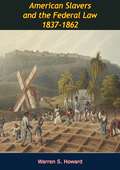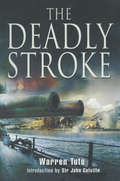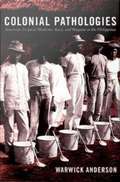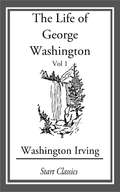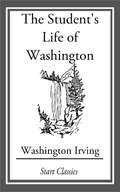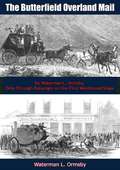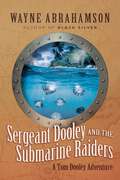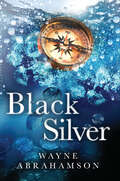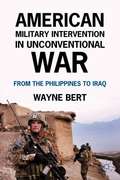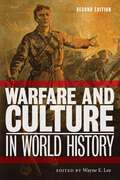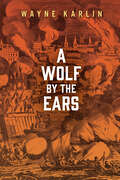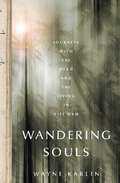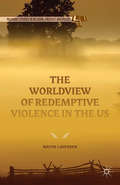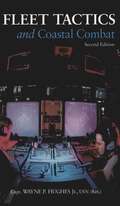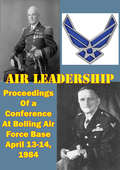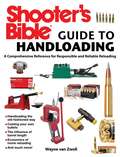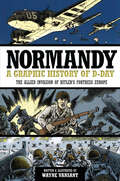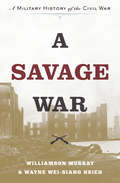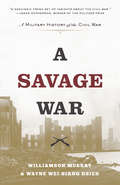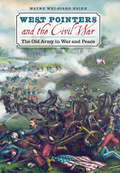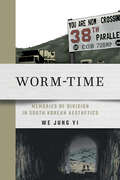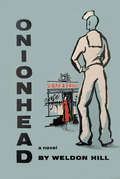- Table View
- List View
American Slavers and the Federal Law 1837-1862
by Warren S. HowardDetailed study of the American government's inability to deal with flagrant violations of federal laws forbidding the use of American citizens, vessels, and port facilities in the international slave trade which flourished in the 1840s and 1850s.
Naval Aviation in the Korean War: Aircraft, Ships and Men
by Warren ThompsonA history of the conflict in Korea with an emphasis on the crucial role of aviation. This in-depth history covers the role of US aircraft carriers and aircraft in stopping the North Korean initial push to the south; their role in the famous Inchon Landing and Pusan Perimeter break out; naval operations during the Marines&’ Chosin Reservoir march to the sea in December 1950; and the stabilization of the front lines after the Chinese entered the war during 1951. At this time, the emphasis for naval air operations was centered on interdiction behind the lines. The focus was on trying to stop road and rail traffic from resupplying the communist troops and allowing them to build up to a major offensive. Also described is the entry of the F2H Banshee into carrier operations, which gave the US four major types of aircraft with which to wage the war. During 1952, most carrier air groups spent their time off the coast of North Korea while hitting targets up along the Yalu River, putting them well within the range of MiG-15s. Navy F9F Panthers were used as top cover, while the Corsairs and Skyraiders went after major targets such as the dam complexes upriver and marshaling yards north of Pyongyang. During 1953, naval air operations were stepped up in an effort to get the communists back to the truce talks. The number of MiG-15s had grown to a figure many times that of the UN for overhead protection; the deep missions were more dangerous than ever; and the Chinese brought in state-of-the-art antiaircraft automatic weapons. This comprehensive book brings you into the action as the stakes get higher and higher before the conflict eventually draws to a close.
The Deadly Stroke
by Warren TuteA history of World War II&’s Battle of Mers-el-Kebir, in which Churchill ordered the sinking of the French fleet to keep it from the Nazis. With the defeat of the French forces by the Germans, Winston Churchill was determined that the French fleet would not fall into German hands, and to that end he ordered that every French ship from Alexandria to Martinique, Portsmouth to Dakar either surrender or be seized. Only those in Algeria committed to the Vichy government refused. In a tragic and ironic battle, the British sank the French fleet at Oran, the author explores in detail the events surrounding this incident.With an introduction by Sir John Colville
First Great Triumph: How Five Americans Made Their Country a World Power
by Warren ZimmermannAmerican history around 1900 with a focus on five figures.
Colonial Pathologies: American Tropical Medicine, Race, and Hygiene in the Philippines
by Warwick AndersonColonial Pathologies is a groundbreaking history of the role of science and medicine in the American colonization of the Philippines from 1898 through the 1930s. Warwick Anderson describes how American colonizers sought to maintain their own health and stamina in a foreign environment while exerting control over and "civilizing" a population of seven million people spread out over seven thousand islands. In the process, he traces a significant transformation in the thinking of colonial doctors and scientists about what was most threatening to the health of white colonists. During the late nineteenth century, they understood the tropical environment as the greatest danger, and they sought to help their fellow colonizers to acclimate. Later, as their attention shifted to the role of microbial pathogens, colonial scientists came to view the Filipino people as a contaminated race, and they launched public health initiatives to reform Filipinos' personal hygiene practices and social conduct. A vivid sense of a colonial culture characterized by an anxious and assertive white masculinity emerges from Anderson's description of American efforts to treat and discipline allegedly errant Filipinos. His narrative encompasses a colonial obsession with native excrement, a leper colony intended to transform those considered most unclean and least socialized, and the hookworm and malaria programs implemented by the Rockefeller Foundation in the 1920s and 1930s. Throughout, Anderson is attentive to the circulation of intertwined ideas about race, science, and medicine. He points to colonial public health in the Philippines as a key influence on the subsequent development of military medicine and industrial hygiene, U. S. urban health services, and racialized development regimes in other parts of the world.
The Life of George Washington
by Washington IrvingWashington Irving's Life of George Washington (published in five volumes in 1856-59) was the product of his last years and remains his most personal work. Christened with the name of the great general, Irving was blessed by Washington while still a boy of seven, and later came to know many of the prominent figures of the Revolution. In these pages he describes them using firsthand source material and observation. The result is a book which is fascinating not only for its subject (the American Revolution), but also for how it reveals in illuminating detail the personality and humanity of a now remote, towering icon. Here is an intimate portrait of Washington the man, from Virginia youth to colonial commander to commander-in-chief of the patriot army to first president and great guiding force of the American federation. But one cannot read Irving's Life without marveling at the supreme art behind it, for his biography is foremost a work of literature.
The Student's Life of Washington; Con: For Young Persons and for the Use of Schools
by Washington IrvingWashington Irving (April 3, 1783 - November 28, 1859) was an American author of the early 19th century. Best known for his short stories The Legend of Sleepy Hollow and Rip van Winkle (both of which appear in his book The Sketch Book of Geoffrey Crayon), he was also a prolific essayist, biographer and historian. Irving and James Fenimore Cooper were the first American writers to earn acclaim in Europe, and Irving is said to have encouraged authors such as Nathaniel Hawthorne, Henry Wadsworth Longfellow, and Edgar Allan Poe. Irving was also the U.S. minister to Spain 1842-1846.
The Butterfield Overland Mail: by Waterman L. Ormsby, Only Through Passenger on the First Westbound Stage (The\huntington Library Classics Ser.)
by Waterman L. OrmsbyThis is the classic firsthand account by Waterman L. Ormsby, a reporter who in 1858 crossed the western states as the sole through passenger of the Butterfield Overland Mail stage on its first trip from St. Louis to San Francisco. Ormsby’s reports, which soon appeared in the New York Herald, are lively and exciting. He describes the journey in close detail, giving full accounts of the accommodations, the other passengers, the country through which they passed, the dangers to which they were exposed, and the constant necessity for speed.“A most interesting account of the first westbound trip of an overland mail stage.”—Southern California Historical Society Quarterly“The best narrative of the trip and one of the best accounts of western travel by stage.”—Pacific Historical Review“If other travelers had been as careful and observant as Ormsby we should know vastly more about our country and the ways of our fathers than we do...The book is fascinating. It will prove interesting to all who care for travelogues, the history of the West, and particularly to those interested in our economic history.”—Journal of Economic History
Sergeant Dooley and the Submarine Raiders
by Wayne AbrahamsonAn ex-sergeant and a decorated combat veteran of America&’s Polar Bear Expedition to Russia, nineteen-year-old Thomas Dooley fought through a brutal winter against Red Russians only to find himself stranded in post-World War I Shanghai. With just over fifty dollars in his pocket, second-hand clothing on his back, and a beat-up Thompson submachine gun in a battered suitcase, he isn&’t sure how he will make it back to the US.To earn his passage home, Dooley finds work on an ex-Russian submarine. He leaves Shanghai under the leadership of Major Dimitri Utkin on a mission that he knows little about. Also on board are others who seek escape—from the dissatisfied captain of a U.S. Navy destroyer, whose chief petty officer is on the hunt for a chest of pirated British gold sovereigns, to a young and destitute Russian countess, Zeta Tolstoy. Dooley&’s expectations are complicated when he realizes that Utkin&’s cadre consists of men traumatized by the war and the Bolshevik Revolution—men who plan to impose their will on America. Before he knows it, Dooley&’s one-week commitment turns into a life-or-death struggle in the depths of the Pacific Ocean.
Black Silver
by Wayne Abrahamson Wayne AbrahamsonJoseph Havok has no idea of the troubles he&’ll face when he and his business partner decide to follow up on a rumor and go off in search of a lost cache of WWII silver near an island in the South China Sea. The two men travel by dive boat to Terumbu Island, unaware of the others they will soon encounter, including an American CIA station chief, an environmental-studies professor, and the captain of the professor&’s research vessel. But Terumbu holds other secrets?, something far more dangerous and much more valuable than the island&’s cache of old silver. Nicholai Anisimova, a former Russian army intelligence officer, is the leader of a group of dissatisfied comrades who threaten international order in their quest to transform Siberia into a new Russia. However, in order to purchase arms and equipment to begin their revolution and occupation of Siberia, the group will need money. To finance the recovery of resources from a sunken Japanese submarine, Anisimova secures the sponsorship of a Chinese industrialist who does not trust the Russians and decides to monitor the recovery himself. Havok and his partner soon find themselves involved in a conflict, refereed by an unknown, seldom-seen island hermit that escalates into a bitter struggle between survivors and pirates. What begins as a simple holiday for two men on a treasure hunt ends with a far-ranging battle that spills beyond the borders of the South China Sea, embroiling world leaders and placing the population of a nation at risk. &“A thrilling and fun adventure built on excellent use of details sprinkled with comedic relief.&” — Kendra Kennedy, Senior Archaeologist &“Abrahamson&’s excellent use of technical details trickled throughout the storyline provides for an authentic, and fast-paced, adventure at every turn of the page.&” — Siska Williams, Senior Archaeologist
American Military Intervention in Unconventional War
by Wayne BertA study of the major U. S. military interventions in unconventional war, this book looks at four wars that occurred while the U. S. was a superpower in the post-war WW II period and one in the Philippines in 1898.
Warfare and Culture in World History, Second Edition (Warfare And Culture Ser. #9)
by Wayne E. LeeAn expanded edition of the leading text on military history and the role of culture on the battlefieldIdeas matter in warfare. Guns may kill, but ideas determine when, where, and how they are used. Traditionally, military historians attempted to explain the ideas behind warfare in strictly rational terms, but over the past few decades, a stronger focus has been placed on how societies conceptualize war, weapons, violence, and military service, to determine how culture informs the battlefield. Warfare and Culture in World History, Second Edition, is a collection of some of the most compelling recent efforts to analyze warfare through a cultural lens. These curated essays draw on, and aggressively expand, traditional scholarship on war and society through sophisticated cultural analysis. Chapters range from an organizational analysis of American Civil War field armies, to an exploration of military culture in late Republican Rome, to debates within Ming Chinese officialdom over extermination versus pacification.In addition to a revised and expanded introduction, the second edition of Warfare and Culture in World History now adds new chapters on the role of herding in shaping Mongol strategies, Spanish military culture and its effects on the conquest of the New World, and the blending of German and East African military cultures among the Africans who served in the German colonial army. This volume provides a full range of case studies of how culture, whether societal, strategic, organizational, or military, could shape not only military institutions but also actual battlefield choices.
A Wolf by the Ears (Juniper Prize for Fiction)
by Wayne Karlin“A novel that vividly examines the struggle of enslaved people to find their freedom, dignity and self-worth as our country struggled.” —Michael Glaser, former Poet Laureate of MarylandWe have the wolf by the ears, and we can neither hold him, nor safely let him go. —Thomas JeffersonDuring the War of 1812, thousands of enslaved people from plantations across the Tidewater rallied to the British side, turning against an American republic that had barred them from the promises of freedom and democracy. Set against the backdrop of rebellion and war, Wayne Karlin’s A Wolf by the Ears follows the interconnected stories of Towerhill and Sarai, two African slaves, and their master, Jacob Hallam. Educated side-by-side and inseparable as children, the three come of age as they are forced to grapple with—and break free of—the fraught linkage of black and white Americans and how differently each defines what it means to fight for freedom. Sarai and Jacob are caught in the tension between the dream of equality, the reality of slavery, and their own hearts, while Towerhill sits at the head of a company of black marines that is part of the force that takes Washington and watches the White House burn.“Wayne Karlin gives us a universe of well-honed, well-realized characters who . . . offer a new dimension about American slavery and what it did to us . . . He shows us war in language that makes him seem not just a storyteller but a witness. Karlin’s work is inspired, a gift, and a pure treasure.” —Edward P. Jones, winner of the Pulitzer Prize for The Known World
Wandering Souls: Journeys With the Dead and the Living in Viet Nam
by Wayne KarlinOn March 19, 1969, First Lieutenant Homer R. Steedly, Jr. , shot and killed a North Vietnamese soldier, Dam, when they met on a jungle trail. Steedly took a diary-filled with beautiful line drawings-from the body of the dead soldier, which he subsequently sent to his mother for safekeeping. Thirty-five years later, Steedly rediscovers the forgotten dairy and begins to confront his suppressed memories of the war that defined his life, deciding to return to Viet Nam and meet the family of the man he killed to seek their forgiveness. Fellow veteran and award-winning author Wayne Karlin accompanied Steedly on his remarkable journey. In Wandering Souls he recounts Homer’s movement towards a recovery that could only come about through a confrontation with the ghosts of his past-and the need of Dam’s family to bring their child’s "wandering soul” to his own peace. Wandering Souls limns the terrible price of war on soldiers and their loved ones, and reveals that we heal not by forgetting war’s hard lessons, but by remembering its costs.
The Worldview of Redemptive Violence in the US
by Wayne LavenderThrough US military history, Lavender directly confronts the dominant US viewpoint of redemptive violence, the concept that a nation can use its military to improve the human condition. Alternatives are presented in order to encourage the current recessive worldview that supports conflict resolution, cooperation, collaboration and peaceful efforts.
Fleet Tactics and Coastal Combat
by Wayne P. HughesThis major revision updates Wayne Hughes's 1986 landmark study that is credited with providing decision makers a sound foundation for battle planning and tactical thinking. The book integrates the historical evolution of tactics, analysis, and fleet operations, and today it can serve as a primer for anyone who wants to learn how navies fight and win. This second edition includes much new material on combat in the missile age and reflects the reconfiguration of many tactics for littoral operations after the fall of the Soviet Union.Hughes recreates famous battles to show how tactics have changed through the ages and the ways in which they have remained unchanged. He covers tactical interaction between land and sea, the sensory revolution of WWII, secret weapons and maritime surprise, the role in battle of leadership and morale, and the importance of surface warships in today's U.S. fleet. He suggests that naval tactics, unlike ground combat, are dominated by the offense and concludes that the great tactical maxim must be attack effectively first.A new chapter traces the evolution of missile tactics at sea and includes details of attacks on ships. Many changes emphasize joint operations and coastal combat. The already extensive appraisal of command and control and information warfare is further expanded to cover modern naval operations and the character of modern salvo warfare. In the tradition of Mahan and Clauswitz, this classic text incorporates literature, politics, and a knowledge of human nature. Indispensable reading for all those interested in naval tactics, it is also a valuable reference for wargamers
Air Leadership - Proceedings of a Conference at Bolling Air Force Base April 13-14, 1984: Proceedings Of A Conference At Bolling Air Force Base, April 13-14 1984
by Wayne ThompsonMore than 200 airmen and historians met in Washington, D.C., on April 13 and 14, 1984, to discuss the men who have led American air forces. The first century of air power is drawing to a close and though some retired air leaders joined in the discussion, many have passed from the scene. What kind of men were they? What kind of leaders were they? What can we learn from their experience?The conference approached broad questions of leadership by taking a close look at two air leaders, Rear Adm. William A. Moffett (1869-1933) and Gen. Carl A. Spaatz (1891-1974). While Chief of the Navy's Bureau of Aeronautics during the 1920s, Moffett did as much as anyone to nurture air power within the Navy. Spaatz, on the other hand, helped to lead the increasingly autonomous Army Air Forces during World War II and became the first Chief of Staff of the independent Air Force when it separated from the Army in 1947.Despite the major roles played by Moffett and Spaatz in the development of American air power, there has been little biographical work on them until recently. A decade ago Alfred Goldberg, chief historian in the Office of the Secretary of Defense, contributed an essay on Spaatz to Field Marshal Sir Michael Carver's The War Lords. Richard G. Davis, an Air Force historian, has just completed a dissertation on Spaatz's service in World War II. Meanwhile the Air Force Historical Foundation has sponsored a biography of Spaatz by Lt. Col. David R. Mets, USAF, Retired, and the first fruit of his effort is one of two essays on Spaatz published here; the other is by Maj. Gen. I. B. Holley, Jr., USAFR, Retired, who has drawn upon his many years as a professor of military history and biographer.
Shooter's Bible Guide to Handloading: A Comprehensive Reference for Responsible and Reliable Reloading
by Wayne Van ZwollA thorough resource on handloading at home, Shooter’s Bible Guide to Handloading provides detailed information about the history of handloading and key figures’ innovations, a simple explanation of hand reloading, selecting the basic tools needed, and choosing your cases, dies, primers, and powders as well as step-by-step instructions for reloading firearm cartridges and how to test your loads at the range. The text is supplemented by more than one hundred detailed photographs that illustrate the various types of reloading equipment available and provide guidance in performing the actions that result in a handloaded cartridge. The Shooter’s Bible Guide to Handloading covers interesting engineering questions the handloader may consider, including bullet integrity, copper bullets, and energy versus killing power. Other topics covered include: Handloading the old-fashioned way Casting your own bullets The influence of barrel length Economics of home reloading And much more! Pick up a copy of the Shooter’s Bible Guide to Handloading to learn everything you need to know about reloading by hand at home.
Normandy: The Allied Invasion of Hitler's Fortress Europe
by Wayne VansantNormandy depicts the planning and execution of Operation Overlord in 96 full-color pages. The initial paratrooper assault is shown, as well as the storming of the five D-Day beaches: Utah, Omaha, Gold, Juno, and Sword. But the story does not end there. Once the Allies got ashore, they had to stay ashore. The Germans made every effort to push them back into the sea. This book depicts the such key events in the Allied liberation of Europe as: 1. Construction of the Mulberry Harbors, two giant artificial harbors built in England and floated across the English Channel so that troops, vehicles, and supplies could be offloaded across the invasion beaches.2. The Capture of Cherbourg, the nearest French port, against a labyrinth of Gennan pillboxes.3. The American fight through the heavy bocage (hedgerow country) to take the vital town of Saint-Lô.4. The British-Canadian struggle for the city of Caen against the &“Hitler Youth Division,&” made up of 23,000 seventeen- and eighteen-year-old Nazi fanatics.5. The breakout of General Patton&’s Third Army and the desperate US 30th Division&’s defense of Mortaine.6. The Falaise Pocket, known as the &“Killing Ground, &” where the remnants of two German armies were trapped and bombed and shelled into submission. The slaughter was so great that 5,000 Germans were buried in one mass grave. 7. The Liberation of Paris, led by the 2nd Free French Armored Division, which had been fighting for four long years with this goal in mind.
A Savage War: A Military History of the Civil War
by Williamson Murray Wayne Wei-siang HsiehThe Civil War represented a momentous change in the character of war. It combined the projection of military might across a continent on a scale never before seen with an unprecedented mass mobilization of peoples. Yet despite the revolutionizing aspects of the Civil War, its leaders faced the same uncertainties and vagaries of chance that have vexed combatants since the days of Thucydides and the Peloponnesian War. A Savage War sheds critical new light on this defining chapter in military history.In a masterful narrative that propels readers from the first shots fired at Fort Sumter to the surrender of Robert E. Lee's army at Appomattox, Williamson Murray and Wayne Wei-siang Hsieh bring every aspect of the battlefield vividly to life. They show how this new way of waging war was made possible by the powerful historical forces unleashed by the Industrial Revolution and the French Revolution, yet how the war was far from being simply a story of the triumph of superior machines. Despite the Union's material superiority, a Union victory remained in doubt for most of the war. Murray and Hsieh paint indelible portraits of Abraham Lincoln, Ulysses S. Grant, William Tecumseh Sherman, and other major figures whose leadership, judgment, and personal character played such decisive roles in the fate of a nation. They also examine how the Army of the Potomac, the Army of Northern Virginia, and the other major armies developed entirely different cultures that influenced the war's outcome.A military history of breathtaking sweep and scope, A Savage War reveals how the Civil War ushered in the age of modern warfare.
A Savage War: A Military History of the Civil War
by Williamson Murray Wayne Wei-siang HsiehHow the Civil War changed the face of warThe Civil War represented a momentous change in the character of war. It combined the projection of military might across a continent on a scale never before seen with an unprecedented mass mobilization of peoples. Yet despite the revolutionizing aspects of the Civil War, its leaders faced the same uncertainties and vagaries of chance that have vexed combatants since the days of Thucydides and the Peloponnesian War. A Savage War sheds critical new light on this defining chapter in military history.In a masterful narrative that propels readers from the first shots fired at Fort Sumter to the surrender of Robert E. Lee's army at Appomattox, Williamson Murray and Wayne Wei-siang Hsieh bring every aspect of the battlefield vividly to life. They show how this new way of waging war was made possible by the powerful historical forces unleashed by the Industrial Revolution and the French Revolution, yet how the war was far from being simply a story of the triumph of superior machines. Despite the Union’s material superiority, a Union victory remained in doubt for most of the war. Murray and Hsieh paint indelible portraits of Abraham Lincoln, Ulysses S. Grant, William Tecumseh Sherman, and other major figures whose leadership, judgment, and personal character played such decisive roles in the fate of a nation. They also examine how the Army of the Potomac, the Army of Northern Virginia, and the other major armies developed entirely different cultures that influenced the war’s outcome.A military history of breathtaking sweep and scope, A Savage War reveals how the Civil War ushered in the age of modern warfare.
West Pointers and the Civil War: The Old Army in War and Peace
by Wayne Wei-siang HsiehMost Civil War generals were graduates of West Point, and many of them helped transform the U. S. Army from what was little better than an armed mob that performed poorly during the War of 1812 into the competent fighting force that won the Mexican War. Wayne Wei-siang Hsieh demonstrates how the "old army" transformed itself into a professional military force after 1814, and, more important, how "old army" methods profoundly shaped the conduct of the Civil War.
Worm-Time: Memories of Division in South Korean Aesthetics
by We Jung YiWorm-Time challenges conventional narratives of the Cold War and its end, presenting an alternative cultural history based on evolving South Korean aesthetics about enduring national division. From novels of dissent during the authoritarian era to films and webtoons in the new millennium, We Jung Yi's transmedia analyses unearth people's experiences of "wormification"—traumatic survival, deferred justice, and warped capitalist growth in the wake of the Korean War. Whether embodied as refugees, leftists, or broken families, Yi's wormified protagonists transcend their positions as displaced victims of polarized politics and unequal development. Through metamorphoses into border riders who fly over or crawl through the world's dividing lines, they reclaim postcolonial memories buried in the pursuit of modernization under US hegemony and cultivate a desire for social transformation. Connecting colonial legacies, Cold War ideologies, and neoliberal economics, Worm-Time dares us to rethink the post-WWII consensus on freedom, peace, and prosperity.
Onionhead: A Novel of the Coast Guard
by Weldon HillAs an insolvent, lonely student at the University of Oklahoma in the days before America's entry into World War II, Al Woods was obsessed with two things: food and sex. He never seemed to have enough of the first, and never seemed to have any of the second. He had known nothing but hard times. He felt himself a member of the Doomed Generation, whose best hope was the least of several evils. Since he thought he was getting nowhere in college, Al joined the Coast Guard; it was better than being drafted, and it offered three square meals a day. Al's story is a novel of the Coast Guard--America's first seagoing outfit, with a tradition that has been neglected in fiction. It is the immensely readable, strongly compelling story of how he became a man through his life in the ships and of how he learned the difference between lust and love through his experiences with the women on shore. There were no heroics in the Coast Guard--at first. There was, for Al, a disillusioning fiasco in the New Orleans' Baronne Street, which made him wonder about all women, and with a special kind of torment, about Josephine Hill, the popular coed at the University to whom he had felt closer than to any other girl. There was routine duty on the buoy tender Skedeelia around the Great Lakes, and the pleasurable discovery that he had the makings of a first-class cook, and the lamentable discovery that in the eyes of his shipmates he had become an "onionhead." There was the growing comradeship with Red Wildoe, his superior in the galley, and with other members of the crew. And there was Stella, whom Al met in a Milwaukee water-front bar. Stella was all woman and all passion. Yet his relationship with her brought a troubling sense that he had betrayed a shipmate's friendship; and for all its sensual satisfactions, something was lacking. He thought that with Jo Hill things would have been different, but her letters told him he had lost her. Before the book is over America has entered the war, Al has seen action in the Atlantic, and learned a lot more about women. Above all he has gained maturity and character, as he proves when he meets the real test of his loyalty. Weldon Hill, a new novelist, has told his story with humor, understanding, and unblinking realism. He has a superb ear for the way people talk, and an innate grasp of how they think and feel.
One World
by Wendell L. WillkieAROUND THE WORLD IN 49 DAYSIn One World Wendell Willkie gives a highly personal account of his meetings with Stalin, Chiang Kai-shek, General Montgomery, General Chennault and other United Nations leaders. He tells of his talks with prime ministers and kings, and with teachers, soldiers, librarians, factory workers, and farmers around the world. He reports a great awakening that is going on among the peoples of the world and his deep conviction that the United Nations must learn to work together now, while they fight, if they hope to live together after the war is over.The publishers believe that One World is a great contribution to the cause of true victory. It is certainly one of the most courageous and outspoken books ever written by a great public figure.“I want to urge every American to read One World. It’s not a book, it’s a searchlight.”—CLIFTON FADIMAN“...he has a seeing eye and an understanding heart....He is a genuine believer in the American way of life....Mr. Willkie’s book becomes a plea that Americans should learn to understand the shrunken world in which they live...”—WALTER LIPPMANN“It is one of the most absorbing books I have read in years, full of humour, shrewd observation, a thousand and one facts you and I never heard but should have. I read it in one gulp.”—WILLIAM L. SHIRER
